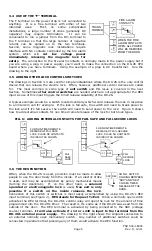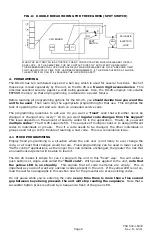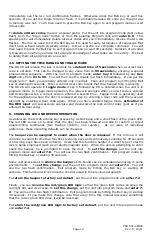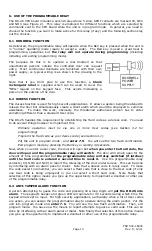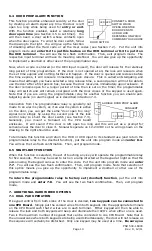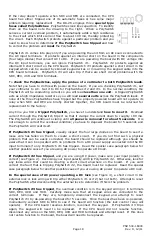
PN# 500-16900
Page 20
Rev. D, 12/11
come on, the problem is with the LED in the keypad or with the internal wiring within the
keypad. The keypad will have to be replaced to restore operation of the LED.
PROBLEM-- Error signal (one second long red pulse) received while programming
Anytime you receive an error signal, retry the programming operation. It’s easy to mis-hit one
key. If the error signal persists, it is almost always a misunderstanding of programming
procedures rather than a fault with the unit. A product fault that impaired the operation of the
microprocessor would generally prevent it from giving you the error signal.
When programming the hard code, you directly enter the code once you are in hard
programming mode (slow yellow flash). Remember you must never pause for more than five
seconds while pressing keys. The only way to get an error signal while programming the hard
code is to enter an illegal one digit code.
When in program mode, the most common error is to forget to enter the two digit memory
slot prefix when attempting to program a code. Valid prefixes are 00-59 and if this step is
forgotten in an attempt to enter the code directly, there are a lot of sequences that will create
an error signal. For example, any sequence that starts with 6 will be rejected. 8-5 is also
illegal. Or if you entered just 9-2, the unit would read 9 as an attempt to change the door open
time and then reject a single digit new time.
Another source of the error signal would be an illegal attempt to enter a program code of less
than five digits (after prefix 0-0). Finally, while programming multiple codes, you will get an
error signal if a code you’re attempting to program is a subset of one already in memory or a
duplicate (see Section 4.4).
PROBLEM-- Door opens on a short code that wasn’t programmed
This can arise through an unnoticed programming error. Suppose you want to program 4-5-1-2.
But when the unit is in program mode, you forget to put in the two digit memory slot prefix but
just directly enter 4-5-1-2. The microprocessor will accept this sequence and interpret it as code
1-2 in memory slot 45. You test the code by re-entering 4-5-1-2 and the door opens because
the sequence includes the real code, 1-2. Later it will be noticed that the door is opening on 1-2
as this is such a simple sequence that it will be entered. When you have any evidence that
unknown codes (particularly short ones) are in the unit, it is best to erase all User codes and
reprogram.
PROBLEM-- How to check the Keypad
For reference, when each key is pressed, two terminals will measure zero volts with respect to
the WHT (common) terminal. You can use a voltmeter to see that each key is working correctly.
Put the positive probe on WHT and when key #1 is pressed you will read roughly zero volts on
VIO and BRN (the other terminals in the matrix will be reading about 11 volts. The terminal pair
that will show zero volts for the other keys are as follows:
#2 = VIO + GRY #3 = VIO + BLK #4 = PNK + BRN #5 = PNK + GRY #6 = PNK + BLK
#7 = ORG + BRN #8 = ORG + GRY #9 = ORG + BLK #0 = BGE + GRY BELL=BGE +BLK
PROBLEM-- Unusual operation complained of after some operating history
"Unusual" operation can be caused by the microprocessor in the CPU Board being disturbed by
electrical noise. Symptoms can vary quite a bit. The unit may forget its codes, the action of the
keypad beeper may become drawn out or erratic, the timer may function at widely varying
ranges, etc. To cure the problem, remove power from the CPU Board for about 10 seconds,
then reconnect it. This forces the microprocessor to reset itself and reload its program. If the
unit has functioned for a long period of time without incident, this may be an adequate fix. The
problem may never reoccur and the end user should be made aware of this simple fix if it should
reoccur. All microprocessors can sometimes "crash" and they are restored by reset. If,
however, the problem is more persistent, steps can be taken to guard against electrical noise
problems. You should make sure that the MOV furnished with the unit is properly installed
across the electric lock (review Figures 3-5). The inductive kickback from electric locks can
often be a source of considerable electrical noise. Noise can also come from the keypad cable,
particularly if its length has been extended. There is no specific distance which is a limit for an
extended keypad cable. Shorter is always better as cable noise varies with the proximity of
Summary of Contents for Securitron DK-26
Page 23: ......

